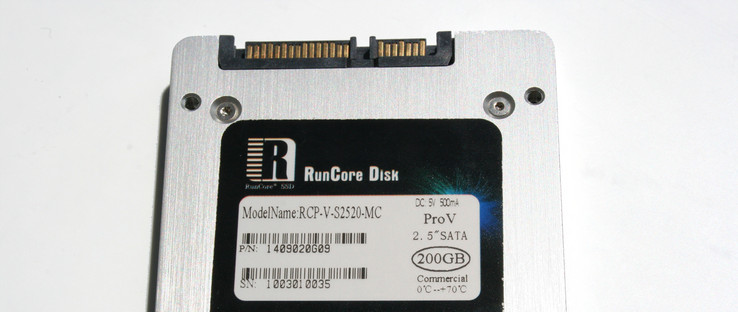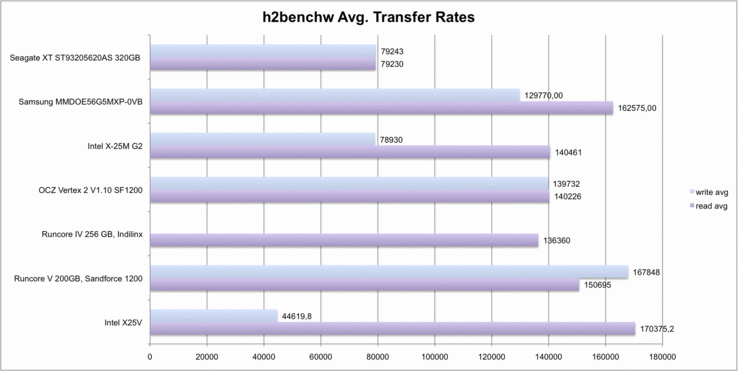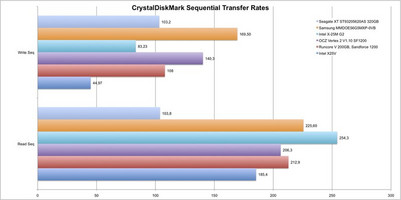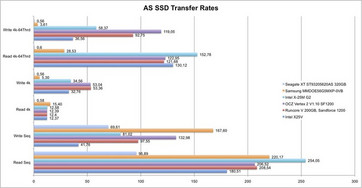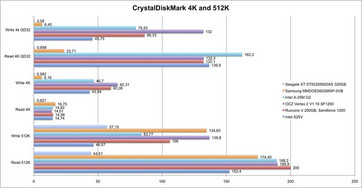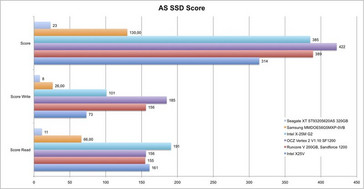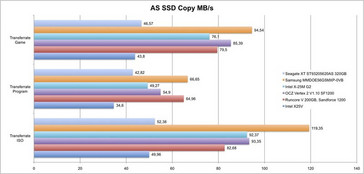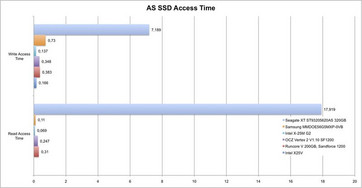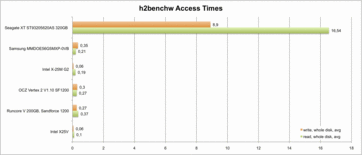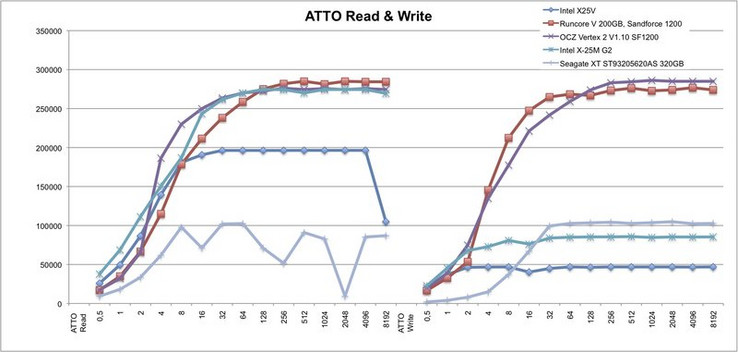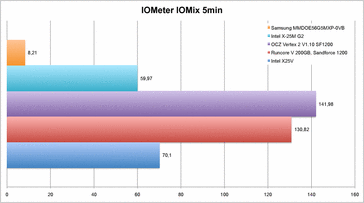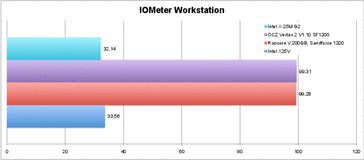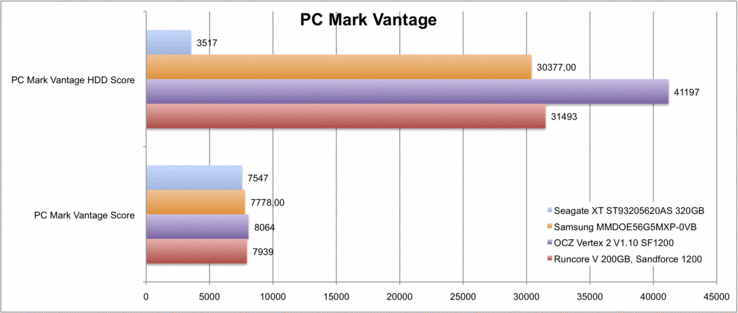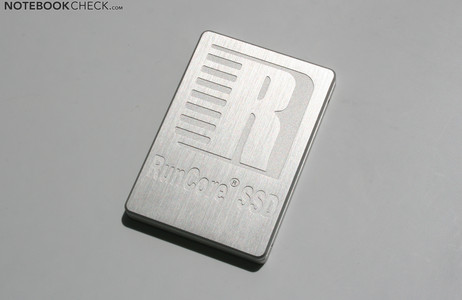Review: Runcore Pro V 200 GB SSD
The Runcore Pro V (website) is a high-end MLC SSD for desktops and notebooks. It's based on the Sandforce 1200 controller with standard firmware and is therefore limited to 10,000 IOPs of 4k writes (SF-1500 30.000 IOPs). The maximum transfer rates are advertised to be 260MB/s for sequential read and write operations. We tested the 200 GB version (256GB in NAND memory on the SSD). Newer versions are shipped with user access to more memory (240 GB) at the expense of wear leveling.
The mechanisms of SSDs as well as their advantages and disadvantages are thoroughly discussed in our Comparison of SSDs and HDDs. Most notably, SSDs at this point offer arguably the most noticeable improvement in performance and are appealing due to their quick access times and high random read and write rates. Because of their design, however, write rates noticeably diminish under heavy use and life spans are limited.
Sandforce Power
The Sandforce controller used by Runcore has some special features that we'd like to mention. It is the first controller that compresses data before writing them into flash memory. According to the manufacturer, the data size is cut down by 50% on average. This way, high maximum write and read rates can be reached while reducing stress on memory cells. Of course, this functions most smoothly with data that is not already compressed.
Another special feature is the function similar to RAID 5 through which the controller can restore data from damaged memory cells. Moreover, data is stored using 128-bit AES encryption.
In our review of the OCZ Vertex 2 (also based on Sandforce SF1200) we encountered another interesting characteristic. After various, intensive tests, the SSD's performance dropped significantly. This appears to be due to a special protection mechanism of the SSD to increase the lifespan of the memory cells. Thus, the SSD goes into a sort of protected mode for several days in order to preserve performance and data integrity in the long run. Under normal daily use, however, the SSD's protection mechanism should not be triggered.
Since the Runcore V was tested with various benchmarks before the Vertex 2 - we only first encountered the phenomenon of reduced performance while testing the Vertex 2 - many of the measurements presented for the Runcore V in this review may have been produced with the protection mechanism activated.
Test System
The various benchmarks performed were carried out on a desktop computer with the following specifications:
• Intel Core i5-750 Quad Core 2.66 GHz
• 4 GB DDR3 RAM
• Intel P55 Chipset
• ATI Radeon HD 4850
The CPU features Speedstep, Turbo and C6 were activated. Only during later tests on the Vertex 2 did we discover that these particular features were responsible for noticeably slower read and write rates in several benchmarks. Apparently, an energy saving mode is activated in the chipset when the CPU is under low stress. Therefore, the results presented should rather be considered the worst case scenario.
The maximum transfer rate of our P55 desktop test computer was limited to about 170MB/s. Therefore, the Intel-based and Sandstorm-based SSDs in the following chart of h2benchw transfer rates could not reach their full speed. The Vertex 2, likewise based on Sandforce1200, reached read and write rates of 235 MB/s with Speedstep, Turbo and C6 deactivated. The Runcore V Pro should also be able to reach such rates, considering this, it did quite well within our limited test computer.
In the CrystalDiskMark benchmark, the Runcore Pro V can keep up with the OCZ Vertex 2's read rate. Speeds here are much less limited and almost reach the level of Vertex 2 without Speedstep, C6 and Turbo (216MB/s). The X25-M G2 and the Samsung SSD, however, trump the Sandforce-based SSDs in the read rate test.
The Runcore Pro V braves the write rate test just as well. The Vertex 2 is able to achieve a higher write speed, apparently due to its modified firmware. Only the Samsung SSD outdoes the two Sandforce-based SSDs.
The AS SSD Benchmark paints the same picture as CrystalDiskMark with satisfactory sequential transfer rates. The 4K read and write rates aren't too meaningful considering they're limited by the chipset. The Vertex 2 got much better results in the 4K test. 4K transfer rates with 64 threads are, nevertheless, reliable and convey the Runcore's good performance on par with the other SSDs. It did particularly well in terms of its write rate, where it ranks in second to the Vertex 2 (with modified firmware), leaving the others a good deal behind.
CrystalDiskMark's 4K tests paint a similar picture. The writing performance of the two Sandforce-based SSDs is particularly good (4K and 512K).
The calculated total score of the AS SSD Benchmark shows the performance power of the Sandforce and Intel SSDs. The Vertex and the Runcore Pro V particularly stand out in the write rate tests and therefore come out in front, just ahead of the Intel SSDs.
In AS SSD's Copy Benchmark, three types of common file types are duplicated (game, program, and ISO files). The transfer rates measured show the Samsung SSD does particularly well, while the Runcore V performs at the level of the Vertex 2 and the Intel X25-M.
The short access times are one of the main reasons for the noticeably faster performance of solid state drives. Traditional hard disks (as well as unconditioned hybrid disks in the first run of testing) are at least 25 times slower. Compared to other SSDs, the Intel SSDs stand out quite a bit. The Sandforce SSDs' automatic compression of data may increase access times. Nevertheless, their performance is on par with that of Samsung SSDs (which read faster but write slower).
In the ATTO Test, the SSDs reach most of their advertised read and write rates. The Runcore Pro V, Vertex 2 and Intel X25-M reach comparable read rates. Intel starts off the fastest but is then passed up by the Vertex 2. The Runcore Pro V takes the longest to "get in full swing", but takes the lead with a transfer rate of 256 KB.
In the write rate test, things are interestingly enough the other way around. The Runcore V starts off better, but the Vertex 2 takes the lead by just a bit. The Intel SSDs stay far behind on account of their writing limitations.
PCMark Vantage measures the performance power of the entire computer. We've included the total score as well as the hard disk score. Here, the Runcore Pro V and the Samsung SSD barely come out ahead, reaching a score similar to that of the X25M (not in chart because without Speedstep). Nevertheless, the Vertex two manages a much higher HDD score.
According to total score, the Runcore V still comes in second just behind the Vertex 2.
Verdict
The Runcore Pro V ranks in among the fastest SSDs on the market thanks to the quick Sandforce 1200 controller. Despite the test computer's limited performance, the Runcore manages to perform very well in all benchmarks and winds up overall just ahead of the Intel X25-M. The OCZ Vertex 2 remains slightly ahead of the Runcore Pro V thanks to its modified firmware. The direct competitor to the Runcore Pro V is the Agility 2, which should offer a similar performance.
The greatest disadvantage of the Runcore Pro V is its sparse availability. In Europe, the SSD is currently available at 8 stores. The Runcore Pro V started off at a higher price than the Intel X25-M. But, like with the Vertex 2, the prices were soon lowered considerably. Since September 21, the SSDs are available at the following recommended retail prices (RRP):
- 60GB $159
- 120GB $299
- 240GB $529
Compared to the Vertex 2 and Agility 2 RRPs, the Runcore Pro V is priced very reasonably. Now, the stores have to follow suit to create a nice price structure.


 Deutsch
Deutsch English
English Español
Español Français
Français Italiano
Italiano Nederlands
Nederlands Polski
Polski Português
Português Русский
Русский Türkçe
Türkçe Svenska
Svenska Chinese
Chinese Magyar
Magyar